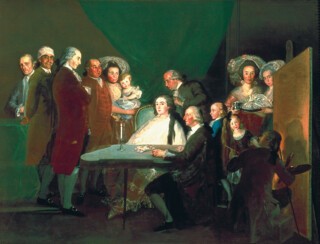Asingle large and not much known picture by Goya, The Family of the Infante Don Luis, on loan from the Magnani-Rocca Foundation in Parma, is on display at the National Gallery until 3 March. Painted in 1784, it was Goya’s first significant royal portrait, a prelude to the painfully truthful Family of Charles IV. It is more rewarding to visit than most exhibitions, however many paintings they include.
Of all portrait genres, the informal group is the most difficult. It depends, first of all, on something that any family snapshot shows is highly unlikely: that a moment exists when the members of a casual, unposed group will not obscure one another’s faces, and, even more implausibly, that they will, at the same time, be seen to interact with each other. In fact, there will, at the very least, be as many backs as fronts, but in this picture the only back you are shown is an impossible one – the one which logic says can’t appear at all unless some game of mirrors is being played like the one implied in Velázquez’s Las Meninas – Goya’s own. (He sits in front of a canvas which, although it has a red ochre ground like the picture itself, seems in its proportions to be quite different.) Nor would a group standing around a card table, as this one does, naturally peel back to give a view in which, despite the implied informality (the lady having her hair dressed, the gentleman playing cards, the baby in its governess’s arms), the protagonists are as neatly and hierarchically spaced out as people in a formal wedding group. One accepts the oddity of the situation the composition proposes, just as one does the joined-yet-separate voices in an operatic set-piece (although I can’t think of one of those in which 13 vocal lines are melded) because its transparent contrivance allows personalities to be contrasted and interesting relationships to be hinted at. It tells more of nature than a natural configuration would allow.
And who is gathered here? The old man playing cards is Don Luis de Borbón, the younger brother of King Charles III of Spain, the woman having her hair done is María Teresa de Vallabriga y Rozas, the bride he chose from among three proposed by his brother when his (Don Luis’s) philandering became too scandalous to bear. When the picture was painted he was 57, she 25. The family, required to live away from the Court, had settled at Arenas de San Pedro, 120 kilometres west of Madrid. Their three children are there too: Luis María, his long hair cascading down his back; María Teresa, showing a lively interest in Goya’s work; and the baby María Luisa in the arms of the governess Isidra de Fuentes y Michel. The combing gesture of the court hairdresser, Santos García, is so perfectly caught that one cannot believe he was not, at some point, watched at work. The tanned man (the kind of face worn, one imagines, by those naval friends of Admiral Croft in Persuasion whose complexions Sir Walter Elliot so reprobates) is probably Don Luis’s secretary Manuel Moreno; the pale-faced man beside him, waiting, it would seem, for the session to be over, may be the composer Luigi Boccherini (Don Luis was keen on music as well as on hunting and science). The man smiling out at us, like a child looking to catch the eye of a parent when he should be attending to his part in the school play, is Boccherini’s constant companion the violinist Manfredi or (a less attractive possibility, but all these identifications are circumstantial) María Teresa’s secretary Francisco del Campo. The maids bringing in lace caps and a box of hair powder on the left are probably her maidservants, Antonia Vanderbrocht and Petronila Valdearenas. The distressed man on the far right is unknown – perhaps one of the court painters who, Goya reported, were incapable of the work he himself is seen doing here.
These identifications are helpful. Few painters make you as curious as Goya does about the people he painted. To look at the picture is to feel in the presence of individuals: men and women differentiated by mood as well as in feature – one owes them a name.
It is not easy to work out how the picture’s remarkable vivacity was achieved. All you can do is observe what’s there and guess what it does to you. The paint work has passages that brilliantly transcribe observed fact – not just the faces, but the glitter of the silver lace you see under the table and the still-life of bonnets – and others so perfunctory you feel a patron could reasonably have sent the picture back for more work. Manuel Moreno’s waistcoat and the jackets of Boccherini and the Manfredi/del Campo figure give the vaguest notion of texture and suggest impossible anatomies. The relation of shoes, legs and feet I frankly find incredible. And whereas Gainsborough – who, at his best, is similarly lively, although much less good at differentiating character – united the surface of his pictures with what appears to be a single feathery brush stroke, Goya seems to have preferred to find marks which work representationally, even if they break up the unity of the picture surface. Could this disjointed style, this mixture of attention and indifference, which inclines you to take the picture piece by piece, have something to do with the clear sense of discrete personalities you get from it? And then there is the vexed matter of truth. One has no need to speculate on Goya’s skill in getting a likeness – it must have been that more than anything else which made his reputation as a portrait painter. More interesting is his apparent inability to subdue individual features into something stereotypical, a habit which could go along with a high reputation for verisimilitude. When you think of Hogarth’s portraits, for example, a particular kind of slightly pop-eyed vigour comes to mind – better for men, children and servants than fashionable people, and relating strongly to his own character. Goya’s portraits come to the memory as a gallery of individuals subdued to no type; The Family of the Infante Don Luis is a most remarkable example of his genius.
Send Letters To:
The Editor
London Review of Books,
28 Little Russell Street
London, WC1A 2HN
letters@lrb.co.uk
Please include name, address, and a telephone number.


